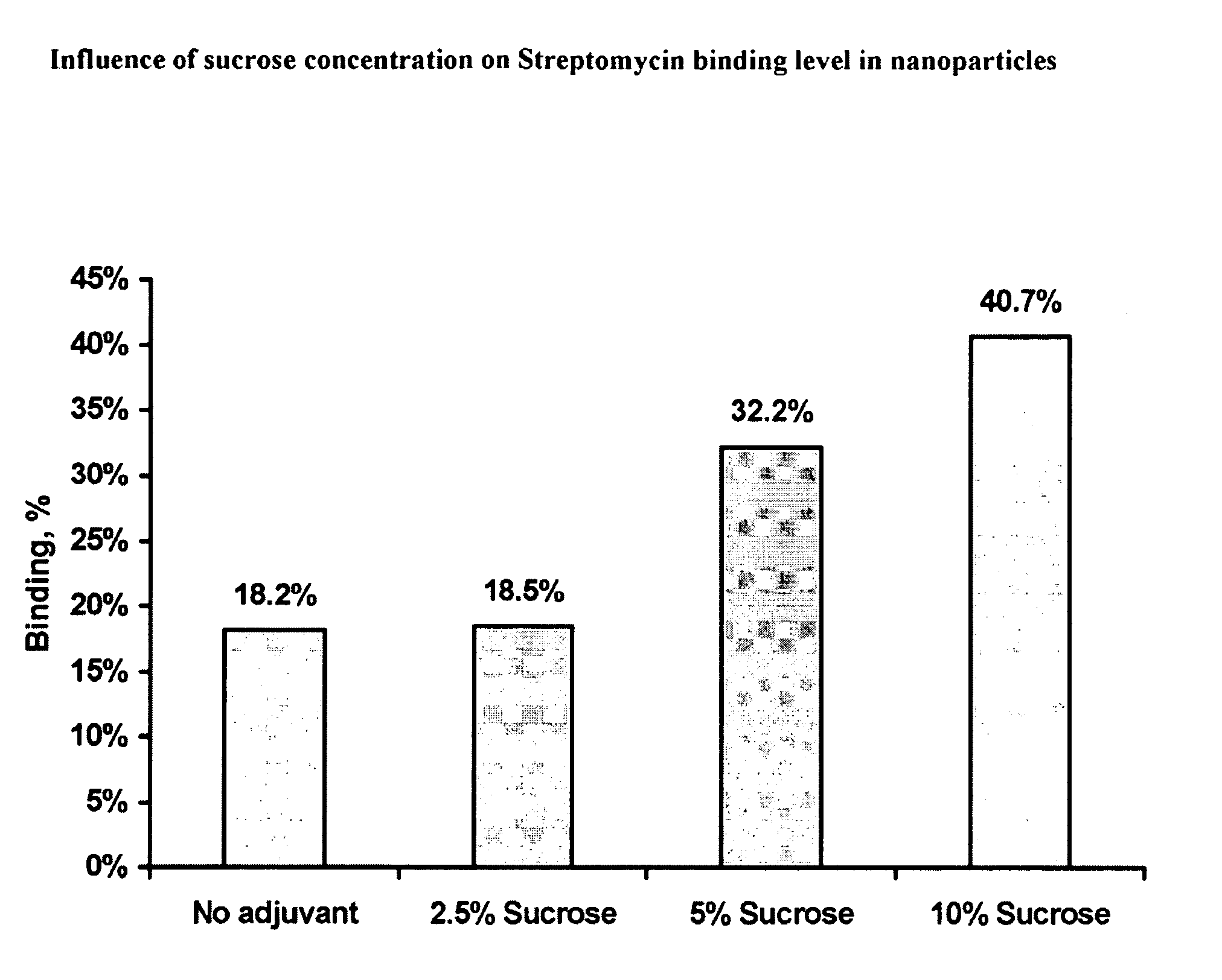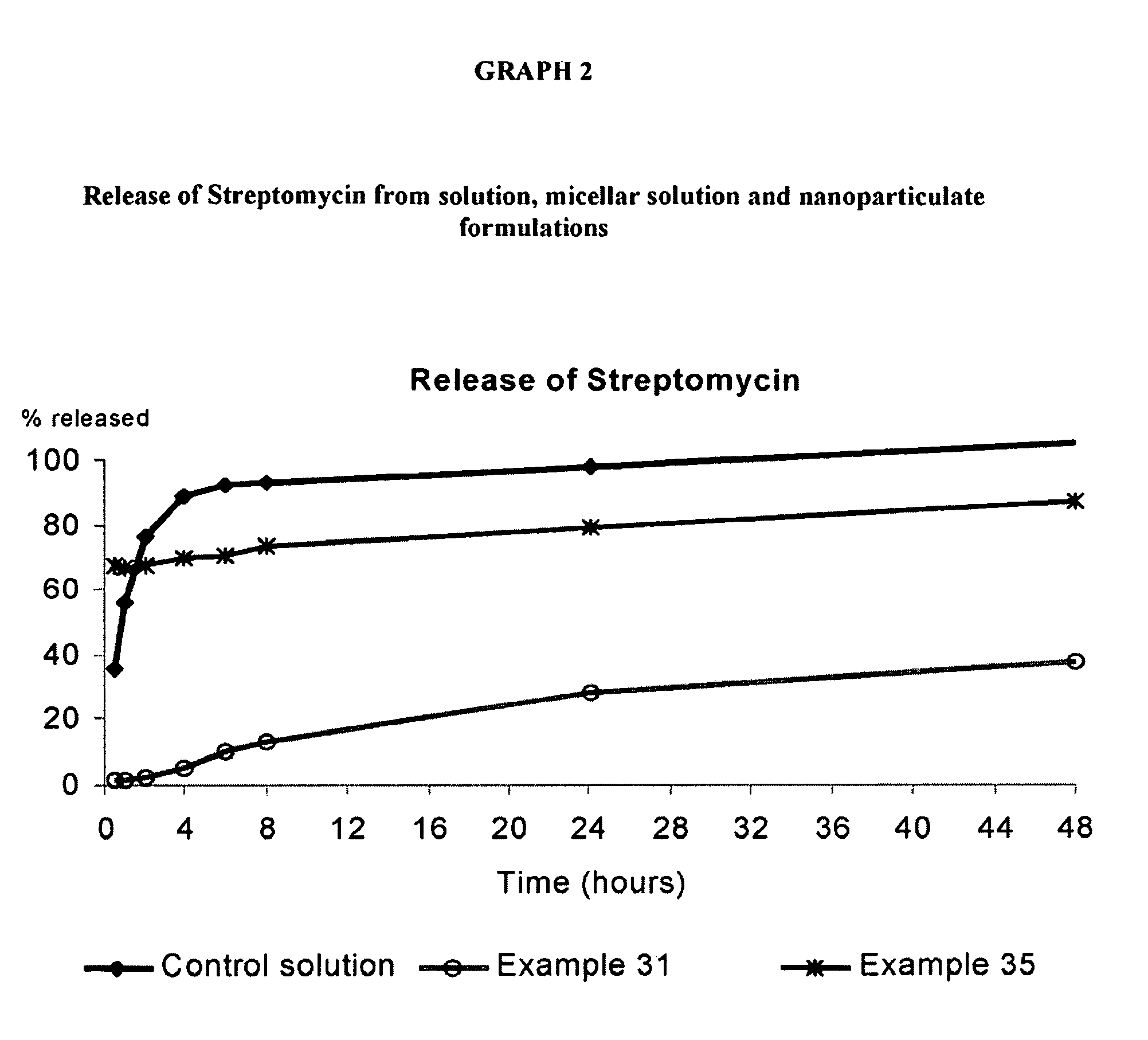Composition and Method of Treatment of Bacterial Infections
a technology of bacterial infections and composition, applied in the field of parenteral delivery, can solve the problems of salmonella /i>spp, especially intracellular infections, and difficult to eradicate facultative intracellular bacterial pathogens, and achieve the effects of significantly reducing mortality rate, cumulative antibiotic dose required, and frequency of drug administration for np formulations
- Summary
- Abstract
- Description
- Claims
- Application Information
AI Technical Summary
Benefits of technology
Problems solved by technology
Method used
Image
Examples
examples36-55
Gentamicin in Biodegradable Polymeric Nanoparticles
[0043]Nanoparticles with Gentamicin were prepared using the same methods, as for Streptomycin loaded nanoparticles (see examples 1-34). Some of prepared composition are presented in the Table 3.
TABLE 3Gentamicin in nanoparticulate formulationsExample #36373839404142434445Gentamicin505050505050500500100100sulfate, mgPolymerRG504SRG504SRG504SRG504SRG504SRG504SRG504SRG503SRG503SRG503SDrug:polymer1:81:81:81:81:81:81:41:41:41:4ratioCounter-ion1%1%1%0.25%0.25%0.25%1%TocSucTocSucTocSucKCholSO4KCholSO4KCholSO4TocSucSurfactant(s)2% F-682% F-685% F-682% F-680.3% F-685% F-681% CremEL2% CremEL1%1%TPGSTPGSAdjuvant(s)0.2% NaSucroseSucrose4%4%caprylate10%10%BSABSAStabilizer——0.1M0.1MNaHPO4NaHPO4Particle size, nm193229167172183155173148245515Binding3.4%6.3%7.9%8.4%22.5%29.1%11.6%24.7%22.1%40.3%(30K membrane)Example #46474849505152535455Gentamicin505050505050100505050sulfate, mgPolymerRG503SRG503SRG503SRG503SRG503SRG503SRG503SRG503SRG502HPCL10KDrug:...
examples 56-64
Vancomycin in Biodegradable Nanoparticles
[0044]Nanoparticles with Vancomycin were prepared using the same methods, as for Streptomycin loaded nanoparticles (see examples 1-34). Vancomycin dissolved in 0.5-1 ml of water phase or butTer (pH <10), containing surfactant. Some of prepared composition are presented in the Table 4.
TABLE 4Vancomycin in nanoparticulate formulationsExample #565758596061626264Vancomycin100100100100100100100100100HCl, mgPolymerRG502HRG502HRG502HRG502HRG502HRG502HRG502HRG502HRG502HDrug:polymer1:41:41:41:41:41:41:41:41:4ratioCounter-ion0.5%0.5%0.25%0.5%0.5%0.5%TocSucTocSucTocSucKCholSO4KCholSO4KCholSO4Surfactant(s)2%2%2%2%2%2% Tween802%2%1% TPGSCremELCremELCremELCremELTween80Tween80CremELAdjuvant(s)0.15M0.05M0.05MSucroseSucrose 10%SucroseSucroseSucroseNaClNa2HPO4Na2HPO410%10%10%10%Stabilizer—0.5% Lipoid0.5% Lipoid0.5% Lipoid0.25%S80HS80HS80HLipoidS80H0.5% CholesterolParticle size,20514615912413712865.47379nmBinding0%3.1%13.5%28.1%18.7%25.1%79.3%82.1%86.8%(300Kmem...
examples 65-73
Levofloxacin in Biodegradable Nanoparticles
[0045]Nanopailicles with Levofloxacin were prepared using the same methods, as for Streptomycin loaded nanoparticles (see examples 1-34). Levofloxacin was dissolved in water phase with pH adjusted to 2.5 using 1N HCl.
[0046]Composition of Example 73 was prepared by precipitation of dissolved combination of polymer, lipid, surfactants, counter-ion and drug from solution in acetone, followed by evaporation of solvent and water.
[0047]Some of prepared composition are presented in the Table 5.
TABLE 5Levofloxacin in nanoparticulate formulationsExample #656667686970717273Levofloxacin, mg10010010010010010010010050PolymerRG504HRG504HRG504HRG504HRG504HRG503RG504HRG504HRG504HDrug:polymer1:101:41:41:41:41:41:41:41:5ratioCounter-ion0.2% Benzoic0.2% Cetyl0.5%0.1%0.5%0.5%0.5% CetylacidphosphateTocSucNaDOCKCholSO4TocSucphosphateSurfactant(s)3%2% Tween802% Solutol0.5%2%2% TPGS1% BSA0.5%1% Span20Tween80HS15TPGSTween80TPGS1% Tween80Adjuvant(s)Sucrose5% PVP1% S...
PUM
| Property | Measurement | Unit |
|---|---|---|
| Fraction | aaaaa | aaaaa |
| Mass | aaaaa | aaaaa |
| Fraction | aaaaa | aaaaa |
Abstract
Description
Claims
Application Information
 Login to View More
Login to View More - R&D
- Intellectual Property
- Life Sciences
- Materials
- Tech Scout
- Unparalleled Data Quality
- Higher Quality Content
- 60% Fewer Hallucinations
Browse by: Latest US Patents, China's latest patents, Technical Efficacy Thesaurus, Application Domain, Technology Topic, Popular Technical Reports.
© 2025 PatSnap. All rights reserved.Legal|Privacy policy|Modern Slavery Act Transparency Statement|Sitemap|About US| Contact US: help@patsnap.com



